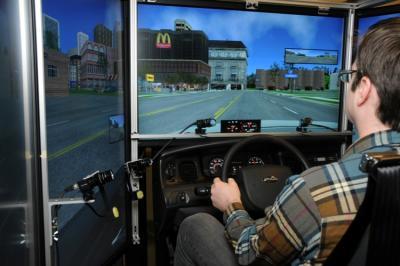No one wants to tell someone they can't drive. America was founded on the pioneer spirit and unless we cramp everyone into urban concrete jungles, which are implicated in any number of health, pollution and crime issues, America's vast expanses mean we are a car culture.
But a diagnosis of hemianopia, blindness in one half of the visual field in both eyes, usually as the result of strokes, tumors or trauma, often means the end of driving. But it isn't required in countries like Belgium, the Netherlands, the UK, Switzerland and Canada if people can pass a specialized road test.
But snap judgments aren't the way to go. How impaired is the loss of vision due to hemianopia?
Researchers at Massachusetts Eye and Ear/Schepens Eye Research Institute set out to determine the extent to which people with hemianopia can compensate for the lost vision when driving, with a long term goal of developing and evaluating devices and training that will assist them to drive more safely.
People with hemianopia have to look (scan) with eye and/or head movements toward the side of the field loss in order to see obstacles or hazards on that side. "The wide field of view that needs to be scanned at intersections presents an especially challenging situation for drivers with hemianopia as they have to scan larger angles than drivers with a full field of vision in order to see all of the intersection on the side of the field loss," said lead author Alex Bowers, Ph.D.
Bowers and colleagues used a driving simulator to evaluate head scanning behaviors of 14 drivers with hemianopia and 12 drivers with normal vision as they approached intersections.

Using a driving simulator, researchers at Massachusetts Eye and Ear/Schepens Eye Research Institute set out to determine the extent to which people with hemianopia can compensate for the lost vision when driving, with a long term goal of developing and evaluating devices and training that will assist them to drive more safely. Credit: Mass. Eye and Ear/Schepens Eye Research Institute
"We found that participants with hemianopia showed compensatory scanning patterns in that their first scan was usually to the side of their field loss. Drivers with right hemianopia tended to look to the right before looking to the left. By comparison, the normally sighted drivers and drivers with left hemianopia typically looked to the left first," Bowers said.
However, the drivers with hemianopia did not compensate by making larger head scans to the side of their field loss, as needed. In fact, their head scans were generally smaller than those of drivers with normal vision. "Yet, you might have expected the opposite as drivers with hemianopia have to scan a long way (close to 90 degrees) in order to see of all of the intersection on the side of their field loss," Bowers said.
Drivers with hemianopia, especially drivers with right hemianopia, had low detection rates for pedestrians that appeared on the side of their field loss. Analyses of the head scans at these intersections revealed that the detection failures were either because the driver never scanned to the side of their field loss, or because they scanned, but not far enough, Bowers said.
"We might have expected that drivers with hemianopia would have had lower rates of failing to scan than drivers with normal vision, but this wasn't the case," Bowers said.
The findings suggest that, although there is evidence of compensation for the hemifield loss in some aspects of their scanning at intersections, the scanning patterns employed by some drivers with hemianopia may be insufficient for safe driving. Based on these individual responses, some drivers might benefit from training tailored to the specific problem areas identified in the study, Bowers noted.
She went on to summarize, "Our results underscore the importance of individualized evaluations for people with hemianopia who wish to resume driving. While some of the participants in our study frequently did not head scan to the side of their field loss, others always scanned to that side. Individualized assessments are an important component of the special provisions (regulations) that enable drivers with visual field loss to demonstrate their ability to drive safely in specialized road tests in other countries."
"Driving with Hemianopia: IV. Head Scanning and Detection at Intersections in a Simulator", Investigative Ophthalmology&Visual Science. Source: Massachusetts Eye and Ear Infirmary




Comments